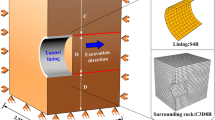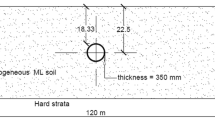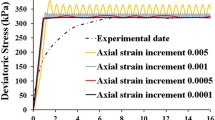Abstract
A numerical simulation method of shield tunnel excavation is developed to capture the time-dependent deformation behaviour of surrounding soil. The simulation method consists of four parts: (i) an elastic-plastic-viscous constitutive model that can not only reasonably describe the viscous deformation behaviour of soil, but also appropriately calculate the plastic deformation under typical stress paths of excavation; (ii) simulation of main factors related to shield tunnel excavation, including the shield machine, face pressure, lining, grout behavior, and contacts between multiple media; (iii) a simulation procedure for excavation to reflect the process of shield tunnel excavation and achieve reasonable stress and strain fields at the end of the construction stage; (iv) a creep process that is used to investigate the long-term mechanical behaviours of the surrounding soil and tunnel lining. Taking the CK570H tunnel project in Taipei as the background, a numerical simulation is conducted by adopting the developed simulation method. Based on the simulation results, the radial and circumferential stresses acting on the lining, which are induced by the surrounding soil viscosity, are analysed. The rule of the mechanical response of lining, including its deformation, bending moment, and axial force, with time is revealed. On this basis, the long-term safety of the lining is evaluated.
Similar content being viewed by others
References
Bjerrum L. Engineering geology of Norwegian normally-consolidated marine clays as related to settlements of buildings. Géotechnique, 1967, 17: 83–118
Morsy M M, Morgenstern N R, Chan D H. Simulation of creep deformation in the foundation of Tar Island Dyke. Can Geotech J, 1995, 32: 1002-1023
Federico A, Popescu M, Elia G, et al. Prediction of time to slope failure: A general framework. Environ Earth Sci, 2012, 66: 245–256
Jamsawang P, Boathong P, Mairaing W, et al. Undrained creep failure of a drainage canal slope stabilized with deep cement mixing columns. Landslides, 2016, 13: 939–955
Mair R J. Tunnelling and geotechnics: New horizons. Géotechnique, 2008, 58: 695–736
Ng C W W, Liu G B, Li Q. Investigation of the long-term tunnel settlement mechanisms of the first metro line in Shanghai. Can Geotech J, 2013, 50: 674–684
Di H, Zhou S, Xiao J, et al. Investigation of the long-term settlement of a cut-and-cover metro tunnel in a soft deposit. Eng Geol, 2016, 204: 33–40
Shirlaw J N. Observed and calculated pore pressures and deformations induced by an earth balance shield: Discussion. Can Geotech J, 1995, 32: 181–189
Causse L, Cojean R, Fleurisson J A. Interaction between tunnel and unstable slope—Influence of time-dependent behavior of a tunnel excavation in a deep-seated gravitational slope deformation. Tunn Undergr Space Tech, 2015, 50: 270–281
Wongsaroj J, Soga K, Mair R J. Tunnelling-induced consolidation settlements in London Clay. Géotechnique, 2013, 63: 1103–1115
Wang Z, Wong R C K, Li S, et al. Finite element analysis of long-term surface settlement above a shallow tunnel in soft ground. Tunn Undergr Space Tech, 2012, 30: 85–92
Jallow A, Ou C Y, Lim A. Three-dimensional numerical study of long-term settlement induced in shield tunneling. Tunn Undergr Space Tech, 2019, 88: 221–236
Xu G, He C, Yang Q, et al. Progressive failure process of secondary lining of a tunnel under creep effect of surrounding rock. Tunn Undergr Space Tech, 2019, 90: 76–98
Yao Y, Lu N, Yang Y, et al. Study of long-termed displacements of a tunnel boring machine during its stoppage. Tunn Undergr Space Tech, 2019, 84: 432–439
Wang H N, Zeng G S, Utili S, et al. Analytical solutions of stresses and displacements for deeply buried twin tunnels in viscoelastic rock. Int J Rock Mech Min Sci, 2017, 93: 13–29
Lu D, Kong F, Du X, et al. Fractional viscoelastic analytical solution for the ground displacement of a shallow tunnel based on a timedependent unified displacement function. Comput Geotech, 2020, 117: 103284
Zhang Z, Huang M, Pan Y, et al. Analytical prediction of time-dependent behavior for tunneling-induced ground movements and stresses subjected to surcharge loading based on rheological mechanics. Comput Geotech, 2021, 129: 103858
di Prisco C, Flessati L, Frigerio G, et al. Experimental investigation of the time-dependent response of unreinforced and reinforced tunnel faces in cohesive soils. Acta Geotech, 2018, 13: 651–670
Zhu H, Ye B, Cai Y, et al. An elasto-viscoplastic model for soft rock around tunnels considering overconsolidation and structure effects. Comput Geotech, 2013, 50: 6–16
Shen S L, Wu H N, Cui Y J, et al. Long-term settlement behaviour of metro tunnels in the soft deposits of Shanghai. Tunn Undergr Space Tech, 2014, 40: 309–323
Zhao K, Janutolo M, Barla G, et al. 3D simulation of TBM excavation in brittle rock associated with fault zones: The Brenner exploratory tunnel case. Eng Geol, 2014, 181: 93–111
Zheng G, Lu P, Diao Y. Advance speed-based parametric study of greenfield deformation induced by EPBM tunneling in soft ground. Comput Geotech, 2015, 65: 220–232
Gui M W, Chen S L. Estimation of transverse ground surface settlement induced by DOT shield tunneling. Tunn Undergr Space Tech, 2013, 33: 119–130
Sharifzadeh M, Tarifard A, Moridi M A. Time-dependent behavior of tunnel lining in weak rock mass based on displacement back analysis method. Tunn Undergr Space Tech, 2013, 38: 348–356
Zhao K, Janutolo M, Barla G. A completely 3D model for the simulation of mechanized tunnel excavation. Rock Mech Rock Eng, 2012, 45: 475–497
Kavvadas M, Litsas D, Vazaios I, et al. Development of a 3D finite element model for shield EPB tunnelling. Tunn Undergr Space Tech, 2017, 65: 22–34
Fu Z Z, Chen S S, Wei K M. A generalized plasticity model for the stress-strain and creep behavior of rockfill materials. Sci China Tech Sci, 2019, 62: 649–664
Xiao Y, Wang C, Zhang Z, et al. Constitutive modeling for two sands under high pressure. Int J Geomech, 2021, 21: 04021042
Yin J H, Zhu J G, Graham J. A new elastic viscoplastic model for time-dependent behaviour of normally and overconsolidated clays: Theory and verification. Can Geotech J, 2002, 39: 157–173
Yin Z Y, Xu Q, Yu C. Elastic-viscoplastic modeling for natural soft clays considering nonlinear creep. Int J Geomech, 2015, 15: 6014001
Yao Y P, Kong L M, Zhou A N, et al. Time-dependent unified hardening model: Three-dimensional elastoviscoplastic constitutive model for clays. J Eng Mech, 2015, 141: 04014162
Qiao Y, Ferrari A, Laloui L, et al. Nonstationary flow surface theory for modeling the viscoplastic behaviors of soils. Comput Geotech, 2016, 76: 105–119
Islam M N, Gnanendran C T. Elastic-viscoplastic model for clays: Development, validation, and application. J Eng Mech, 2017, 143: 04017121
Lu D C, Miao J B, Du X L, et al. A new method of developing elasticplastic- viscous constitutive model for clays. Sci China Tech Sci, 2020, 63: 303–318
Debernardi D, Barla G. New viscoplastic model for design analysis of tunnels in squeezing conditions. Rock Mech Rock Eng, 2009, 42: 259–288
Schanz T, Vermeer P A, Bonnier P G. The hardening soil model: Formulation and verification. In: Proceedings of International Symptom Beyond 2000 in Computational Geotechnics-10 Years of Plaxis International. Rotterdam, 1999. 1–16
Tornborg J, Karlsson M, Kullingsjö A, et al. Modelling the construction and long-term response of Göta Tunnel. Comput Geotech, 2021, 134: 104027
Purwodihardjo A, Cambou B. Time-dependent modelling for soils and its application in tunnelling. Int J Numer Anal Meth Geomech, 2005, 29: 49–71
Lu D C, Miao J B, Du X L, et al. A 3D elastic-plastic-viscous constitutive model for soils considering the stress path dependency. Sci hina Tech Sci, 2020, 63: 791–808
Abaqus. Abaqus User’s Manual Version 6.12. Providence: Dassault Systèmes Simulia Corp., 2012
Yao Y P, Lu D C, Zhou A N, et al. Generalized non-linear strength theory and transformed stress space. Sci China Tech Sci, 2004, 47: 691–709
Lade P V, Liggio Jr. C D, Nam J. Strain rate, creep, and stress dropcreep experiments on crushed coral sand. J Geotech Geoenviron Eng, 2009, 135: 941–953
Kasper T, Meschke G. On the influence of face pressure, grouting pressure and TBM design in soft ground tunnelling. Tunn Undergr Space Tech, 2006, 21: 160–171
Chapman D N, Ahn S K, Hunt D V. Investigating ground movements caused by the construction of multiple tunnels in soft ground using laboratory model tests. Can Geotech J, 2007, 44: 631–643
Gui M W, Chien M C. Blast-resistant analysis for a tunnel passing beneath Taipei Shongsan Airport—a parametric study. Geotech Geol Eng, 2006, 24: 227–248
Vermeer P A, de Borst R. Non-associated plasticity for soils, concrete and rock. Heron, 1984, 29: 1–64
Kasper T, Meschke G. A 3D finite element simulation model for TBM tunnelling in soft ground. Int J Numer Anal Meth Geomech, 2004, 28: 1441–1460
Zhang M, Li S, Li P. Numerical analysis of ground displacement and segmental stress and influence of yaw excavation loadings for a curved shield tunnel. Comput Geotech, 2020, 118: 103325
Carranza-Torres C, Diederichs M. Mechanical analysis of circular liners with particular reference to composite supports. For example, liners consisting of shotcrete and steel sets. Tunn Undergr Space Tech, 2009, 24: 506–532
China Academy of Building Research. Code for design of concrete structures (in Chinese). GB 50010. 2010
Author information
Authors and Affiliations
Corresponding author
Rights and permissions
About this article
Cite this article
Miao, J., Lu, D., Lin, Q. et al. Time-dependent surrounding soil pressure and mechanical response of tunnel lining induced by surrounding soil viscosity. Sci. China Technol. Sci. 64, 2453–2468 (2021). https://doi.org/10.1007/s11431-021-1908-6
Received:
Accepted:
Published:
Issue Date:
DOI: https://doi.org/10.1007/s11431-021-1908-6




